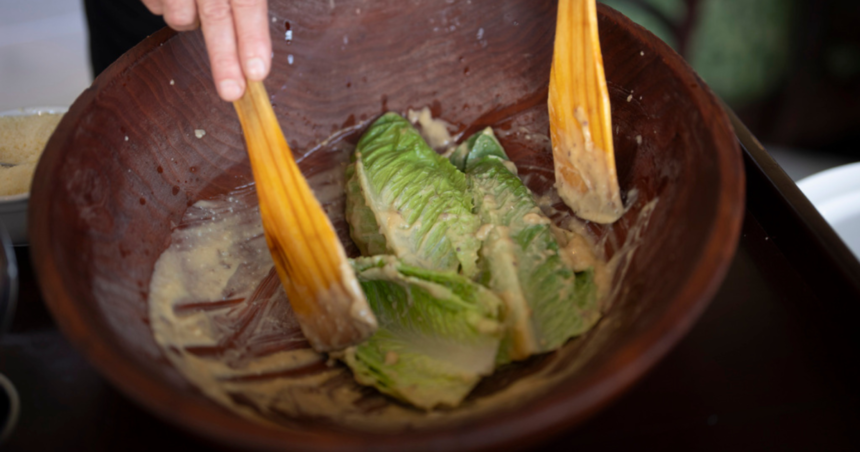Caesar salad is marking a special occasion: It’s reaching its 100th anniversary.
Legend has it that Italian immigrant Caesar Cardini created the dish on July 4, 1924, at his eatery, Caesar’s Place, in Tijuana, Mexico. On a hot evening, while struggling to serve a surge of Californians escaping Prohibition, Cardini concocted the now-famous salad from Romaine lettuce, garlic-infused oil, Worcestershire sauce, lemons, eggs, and Parmesan cheese. And so, a culinary star was born.
Tijuana is preparing to honor the milestone with a three-day culinary celebration and the installation of a statue of Cardini. Even today, at Caesar’s – a fancy establishment opened by Cardini in Tijuana a few years later – 300 Caesar salads are still prepared daily.
Unlike other dishes from the early 20th century that have faded into obscurity, like creamed liver loaf or aspic, Caesar salad has remained a perennial favorite. Approximately 35% of American restaurants feature Caesar salad on their menus, and Nielsen IQ reports that nearly 43 million bottles of Caesar salad dressing, worth $150 million, were sold in the U.S. last year.
Beth Forrest, a professor at the Culinary Institute of America, notes that it took some time for Caesar salad to gain widespread popularity. The recipe did not appear in the “Joy of Cooking” until the 1951 edition. During the 1960s and 1970s, Caesar salad was often prepared tableside, adding an element of elegance and flair.
Forrest explains that Caesar salad resonates with Western palates due to its perfect blend of crispy and creamy textures. The egg yolks and Parmesan cheese provide a rich, savory flavor known as “umami.”
“It offers indulgence while maintaining a sense of virtuousness—it’s a salad, after all,” Forrest adds.
Experts credit Caesar salad’s enduring appeal to its numerous variations. Chefs may include additions like chicken, bacon, or salmon, experiment with ingredients such as kale or brussels sprouts, and create dressings with miso paste or tofu.
At Beatrix, a restaurant chain in Chicago known for healthier comfort food, chef Andrew Ashmore concocts a unique Caesar salad. This dish involves yogurt-based dressing blended with capers, parsley, lemon vinaigrette, and champagne vinegar, served with little gem lettuce, baby arugula, bread crumbs, and Grana Padano cheese.
Cheyenne Cohen/AP
“It remains our best-selling salad, even after 11 years of operation,” Ashmore affirms. “I couldn’t remove it from the menu if I tried.”
Cardini was particular about his recipe. According to his daughter Rosa Cardini’s 1987 interview with the Honolulu Star-Bulletin, he used only the tender inner Romaine lettuce leaves, kept whole for diners to pick up by hand. He briefly boiled the eggs and omitted anchovies from the dressing.
There are conflicting stories about the salad’s origins. Some credit Livio Santini’s mother, one of Cardini’s chefs and an Italian immigrant, while others claim Cardini’s brother Alex created a version with limes and anchovy paste, calling it “Aviator’s Salad” because it was served to airmen from a San Diego base.
Forrest notes that the salad’s recipe shares similarities with traditional Italian dishes like pinzimonio or bagna cauda, an olive oil and lemon juice dipping sauce or a hot anchovy and garlic dip from Cardini’s birthplace, the Piedmont region.
Despite not responding to inquiries about the salad’s history, Caesar’s in Tijuana acknowledges Santini on its website.
Following the end of Prohibition, Tijuana’s business dwindled, prompting Caesar Cardini to relocate his family to Los Angeles in 1935. They initially bottled the Caesar dressing at home before establishing Caesar Cardini Foods Inc.
After Caesar’s passing, his daughter Rosa took over the family business in 1956, expanding its offering to include 17 other dressings. T. Marzetti acquired Cardini Foods in 1996 and continues to market Caesar Cardini’s original dressings.





